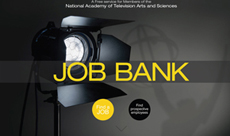Editor’s Note: San Francisco’s KPIX 5 — the Bay Area’s first television station — is celebrating its 70th anniversary this fall, leading up to its very first day on the air on Dec. 22, 1948. Below is a colorful and very entertaining look back at the station’s history and its place in Bay Area history. This KPIX article was originally written for the station’s website. All of us at the San Francisco/Northern California Chapter of The National Academy of Television Arts & Sciences salute KPIX for its seven decades of outstanding television broadcasting.
This year, KPIX is celebrating a major milestone. KPIX was the first television broadcasting station in Northern California and the 49th in the nation. Channel 5 went on the air with its inaugural broadcast 70 years ago on Dec. 22, 1948.
The station has shared a lot of history and memories with Bay Area viewers and its story begins where the cable cars climb.
At Mason and California streets on San Francisco’s historic Nob Hill sits the Intercontinental Mark Hopkins, one of the most prestigious hotels in the world.
More than 300 feet up, no matter where you look, the view is breathtaking. Seventy years ago, it was the highest point in downtown San Francisco. Above the famous “Top of the Mark,” there is an attic and that’s where Channel 5 began.

KPIX General Manager Philip Lasky speaks on the roof of the Mark Hopkins Hotel. (CBS)
Leading up to KPIX’s inaugural broadcasstation engineers were hard at work in that attic. General Manager Philip Lasky and Chairman Wesley I. Dumm of The Associated Broadcasters shepherded the station on-air.
They brought what was, at the time, sophisticated broadcast equipment from RCA via the Flying Tigers to San Francisco. The team had already brought the Bay Area KSFO radio, and now it was time to turn to television and bring visual broadcasting to Bay Area homes.
On the roof, engineers installed the Bay Area’s first TV broadcast antenna.
Penny Wilkes, the late Mr. Dumm’s daughter, shared historic photos with KPIX. Hoisting the transmitting antenna to the roof took quite an effort.
In the months leading up the inaugural broadcast, retailer Sherman Clay began to advertise in local papers, tantalizing readers with the promise of the upcoming “T” day. Sherman Clay was founded in San Francisco and the store was a publisher and seller of sheet music as well as musical instruments. The company began to sell television sets but needed the help of KPIX.
KPIX began sending out test patterns so that Sherman Clay representatives could show interested customers how television worked and how they could adjust their sets for the best quality picture.
In the attic of the Mark Hopkins, the transmitter and master control were installed so that engineers could kept a close eye on the transmissions and be close to the new antenna, “To make sure it has the proper quality so the viewers enjoy the best possible picture,” explained engineering director Roald Didrikson
On the ground floor of the hotel annex, the studios hummed with talent. KSFO radio had 11 studios already installed and KPIX used the largest one, known as Studio 11.
The inaugural broadcast began at 6:45 p.m. — again with a test pattern — so owners of the newfangled TV sets could fine-tune the picture. An estimated 600 TV sets had been purchased by the time the broadcast began.
After a 15-minute test pattern, viewers were treated to “Howdy Doody,” a half-hour children’s program.
At 7:30 p.m., viewers watched a 30-minute film entitled “Valley of Heart’s Delight.”
Next came a five-minute news broadcast, then a 10-minute cartoon called “The Santa Claus Story,” followed by a half-hour football movie called “Touchdown.”
The historic night ended with the first ice hockey game televised in the Bay Area, a game between the San Francisco Shamrocks and the Oakland Oaks.
A day before this broadcast day KPIX engineers did a practice run on Dec. 21, with a remote production at Winterland — then the home of the Shamrocks, where the San Francisco team practiced. Producers, cameramen and technicians wanted to find out if they could cover a game that moved as fast as ice hockey and practiced following the puck so they’d be ready for the real game on inaugural night.
On New Year’s Day, ten days after that first broadcast, KPIX was first to televise the East-West Shrine game at Kezar Stadium.

The station gained a reputation for tackling ambitious live remotes — live broadcasts away from studio facilities.
“Doing a television remote was a big affair regardless of who was in front of the camera,” explained Prof. Herbert Zettl, who worked for both KPIX and CBS on some of the station’s remotes. He went on to design the studios at San Francisco State University, where he taught broadcasting and wrote the definitive book on television production.
On Sept. 4, 1951, KPIX broadcast the first live coast-to-coast TV coverage of a major news event.
From the San Francisco Opera House, President Harry Truman proclaimed the official end of World War II and the Allied postwar occupation of Japan with the Treaty of San Francisco. Forty-eight nations at the event officially signed the treaty, which would take effect the next year.
“I’m glad to welcome you to this conference for the signing of peace with Japan,” declared Truman on the live broadcast. KPIX originated the coverage for CBS News.
KPIX cameras also helped legendary journalist Edward R. Murrow with his first episode of “See it Now,” which was nationally broadcast on Nov. 18, 1951. Murrow was in CBS’s New York studios and showed his audience how television could do simultaneous live, coast-to-coast transmissions.
First, Murrow summoned WPIX to provide an image of the Brooklyn Bridge. Then it was San Francisco’s turn.
“May we have the Pacific Coast please?” intoned Murrow. A KPIX camera came into view with a beautiful image of the Golden Gate Bridge. Then, Murrow asked for more.
“San Francisco can you use what’s called a “zoomar” lens and close in on that bridge a little?” Murrow asked.
“Roger,” replied a KPIX operator, as viewers across the nation saw our remote camera zoom in for a tighter shot.

Families of Korean War veterans await their return home aboard the USNS USNS General Nelson M. Walker, August 23, 1953. (CBS)
Another ambitious remote: when POWs from the Korean War came home. KPIX provided images for CBS News on Aug. 23, 1953. The station had reporters and remote cameras at Fort Mason in San Francisco as the USNS General Nelson M. Walker pulled up to dock.
KPIX reporter Lee Giraud stood with the waiting families. He was beside the Curry family from Illinois — a mother with her two little boys — when he leaned over to one of the boys and asked him a question.
“You think you’re going to know your daddy when you see him again?,” Giraud asked.
“I think so,” replied the little boy, looking a little anxious.
Then, more than 300 POWs came down the gangway and into the arms of their loved ones. Those two little boys found their dad and their mom hugged him tight.
In the crush was a Sergeant Dixon from San Jose and KPIX reporter William Winters interviewed him.
“Would you look into the camera so all the other folks in San Jose and the USA can take a look at you?” asked Winters.
Dixon described how the Chinese treated American POWs (“OK” he said) and how North Koreans often did not take POWs, they just killed them. Viewers could see Mrs. Dixon hold her husband tighter.
Even before the USS Walker broadcast, the demand for bigger and better broadcasts had exploded and, by 1952, KPIX had outgrown the Mark Hopkins Hotel.
To fill the need, the station built the Bay Area’s first modern broadcasting facility. The location: Van Ness and Greenwich streets in San Francisco. The three-story building would hold three state-of-the-art broadcast studios. The transmitter and antenna moved to Mount Sutro.
KPIX then went full throttle. Brand new shows included “Adventure School,” which was hosted by the late Marian Koelher Rowe, and “Marshal J” with his Dalmatian called Rowdy. His set was a ranch house. For the teeny-bopper crowd, KPIX broadcast “Dick Stewart’s Dance Party.” High school kids from around the Bay Area would flock to the studios on Van Ness to be part of the newest dance craze.
“Ninety minutes a day, six days a week with teenagers dancing,” laughed Dave Parker, one of the KPIX directors at the Van Ness location. He remembers some students came from nearby Galileo High School at Van Ness and Francisco streets. After their last class in the afternoon, the students walked a few blocks and stood in line. Parker called them “the regulars.”
“These were kids who we particularly liked and they were asked to come back, again and again and again,” remembered Parker.
Bay Area swing and big band leader Del Courtney hosted a live variety show and featured guests like Johnny Mathis, Doris Day, Ella Fitzgerald and Sammy Davis Jr. On the show, viewers would see “in studio” car commercials, where a beautifully dressed woman would show off a featured vehicle. On one show, a Pontiac Star Chief displayed — with all the bells and whistles — for $2,988.
Then, of course, there was the old favorite known as Teletours. The host would bring landmarks and interesting events that were occurring around the Bay Area into your living room.
KPIX was also a pioneer in TV news. In 1959, the station broadcast the first half-hour news show in Northern California. “The Noon News” featured “Guy on the Beat” John Weston and “Girl on the Beat” Wanda Ramey.
Ramey fought to do harder stories than the lighter fare usually assigned to her. On July 7, 1960, she attended a press conference in San Francisco where Lyndon Johnson was campaigning for the Democratic presidential nomination. She grilled him on the Democratic Party’s platform, asking if student demonstrators should receive the same kind of support given to civil rights advocates.
“Do you think that should they come out in support of the student demonstrators?” asked the TV pioneer. Ramey was the first female newscaster in the western United States.
In 1962, “The Big News” hit the airwaves. The program was the Bay Area’s first full hour of nightly news and featured the anchor team of Don Bryce, Nancy Clark and Glen Hanson.
Four years later, KPIX hired the talented Ben Williams, one of the first African-American reporters in the country. Also in 1966, KPIX hired Belva Davis, making her the first black female television journalist on the West Coast.
Over the course of her career, Davis would become a national treasure. Although she had no TV experience, she was already an accomplished print and radio reporter when she joined KPIX. Davis would eventually retire from television with seven Emmy® Awards, becoming one of the most respected and trusted journalists in the nation.
“I worked with so many talented people in those early days at PIX. It was just … it was just amazing,” remarked Davis.
During the 60s and 70s, from the Van Ness location, KPIX covered it all: the good, the bad and the ugly.
From student protests, Robert Kennedy’s assassination, the kidnapping and trial of newspaper heiress Patricia Hearst, the Black Panthers, the horror of Jim Jones and Jonestown, the Milk-Moscone murders to the hippies, the counterculture and general Bay Area craziness.
Remember the Beatles’ final show at Candlestick Park in 1966? Before that appearance, there was an earlier visit in 1964 for a gig at the Cow Palace and the start of their first North American tour. The Fab Four’s raucous arrival at San Francisco International Airport was captured by KPIX crews.

KPIX reporter Rod Sherry speaks with Beatles fans awaiting their arrival at San Francisco International Airport, August 18, 1964. (CBS)
At the time, everything was shot and edited on film.
“We had film at KPIX. When I started, you have to give that film time to develop.” said former news anchor Wendy Tokuda, who began working at KPIX in 1978. She was the first Asian-American to anchor a Monday through Friday, prime time newscast in the Bay Area.
Her co-anchor was an Oakland native: the legendary Dave McElhatton. His KPIX co-workers called him “Mac” and he was well-loved. Mac was a radio broadcaster who took television news by storm. Along with Wayne Walker in sports and Joel Bartlett with the weather, KPIX or “Eyewitness News” as the news was then called, soared to number one in the market.
“It was a golden time, there’s no question about it,” remembered Tokuda. “It was a golden time for local television in this beautiful city.”
In 1976, technology local television around the country when a new show debuted on KPIX: “Evening Magazine.”
“Our show was the very first show to use video out in the field,” remarked former “Evening” host Jan Yanehiro.
Evening Magazine was a locally-produced magazine show. Yanehiro’s first co-host was Steve Fox who stayed for three years. He was replaced by Richard Hart and the two would host the program until it ended in 1991. The use of portable, battery-run cameras that shot on magnetic tape cassettes allowed “Evening Magazine” crews to stay in the field and on location.
“We were not in a studio,” remarked Hart. “We took the video everywhere and it was not film, as Jan pointed out.”
“3/4 inch tape!” exclaimed Yanehiro, referring to the width of the U-matic cassette tapes.
The use of video was — at the time — shunned by newsrooms, as many believed it would never work out or last. KPIX News would shift to the new technology.
The Van Ness studios churned out even more shows, including “People are Talking” with Ann Fraser and Ross McGowan. They were the king and queen of daytime television in the Bay Area. The show began in 1978 and ran until 1992. Some of their notable shows included visits to a nudist colony, to San Quentin State Prison and to the AIDS ward at San Francisco General Hospital.
By 1979, KPIX had outgrown its studios at Van Ness and Greenwich. There were so many shows and people working there, KPIX had to rent out space in a building across the street. It was time to move once again.
The station packed up the studios and headed to 855 Battery Street. The five-story building was an old warehouse for the American Biscuit Company, later known as the National Biscuit Company, Nabisco for short.
Where cookies and candy were once made, KPIX now made the news.
“The first thing that struck me when I walked in was that it was beautiful, clean, and there were so many people,” remarked former anchor and reporter Kate Kelly.

KPIX 5 News team in 1986: (L-R) Joel Bartlett, Dave McElhatton, Wendy Tokuda, Wayne Walker
Over these last decades, from the station’s current 855 Battery home, KPIX has covered Bay Area news, weather, sports, social unrest, technology, politics, lifestyles, entertainment, the environment, AIDS, papal visits, human tragedies, fires, droughts, catastrophes, and triumphs.
Breaking news was always the main focus.
“When a big breaker would happen, you’d hear it immediately; the whole newsroom, the decibels would go up. The executive producer and the news director would come out of their offices there would be bells ringing on the teletype machines,” said Kelly.
Perhaps some might remember a signature feature of those broadcasts: The Eyewitness Newsreel at the end of every show.

Dave McElhatton as he anchors coverage of the Loma Prieta earthquake in 1989.
Aside from Bay Area and national news, KPIX delivered news from across the globe, including the occupied territories, East Germany during the fall of the Berlin Wall, the Soviet Union, Romania, Afghanistan, Iraq, Honduras and countries on the African continent.
Former anchor Dana King traveled to Rwanda to report on the horrific genocide.
“Helping people understand what happened, why it happened, who it happened to and to also understand that it could happen anywhere,” explained King.
Before the newsroom became digital, crews lugged around big recorders and portable cameras in the field. The tape became smaller and smaller. At the same time, computers came to the newsroom.
“We kept the typewriters in case the computers crashed and, in fact, one day they did,” recalled Tokuda.
Today, staffers still walk by one old IBM typewriter in the newsroom, stashed next to the Xerox machine, near the office supplies.
The technology kept improving. It got smaller, better and faster.
“We had to change our game and we had to change the way we told our news,” said Tokuda. “It became more immediate.”
These days? Just ask former anchor and reporter Hank Plante.
“You can do a live shot in a newscast using an iPhone and you can put it on a selfie stick and you can do that from anywhere in the world,” said Plante.
Now, we stream news updates all day long on nine digital platforms. Exclusive cameras on top of the Salesforce Tower, as well as Sky Drone 5, provide unparalleled views
Whether it be breaking news, weather, sports, consumer coverage, original or investigative reports — we’ve got you covered.
Here’s to 70 more years.










